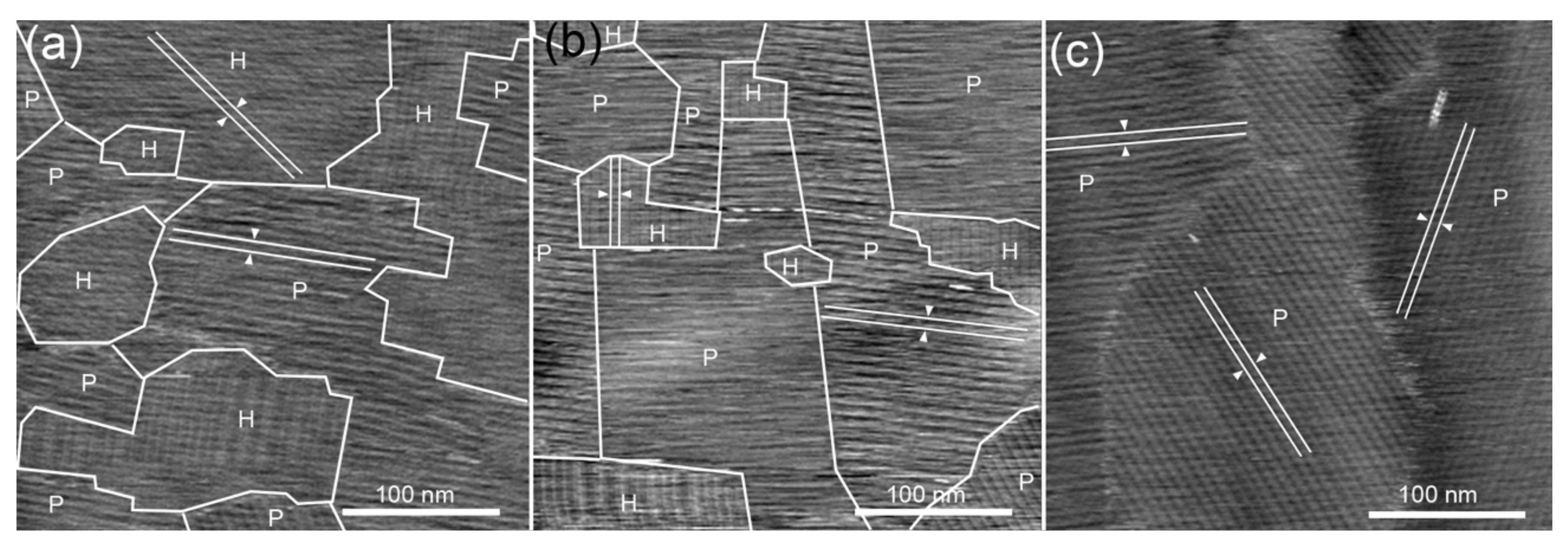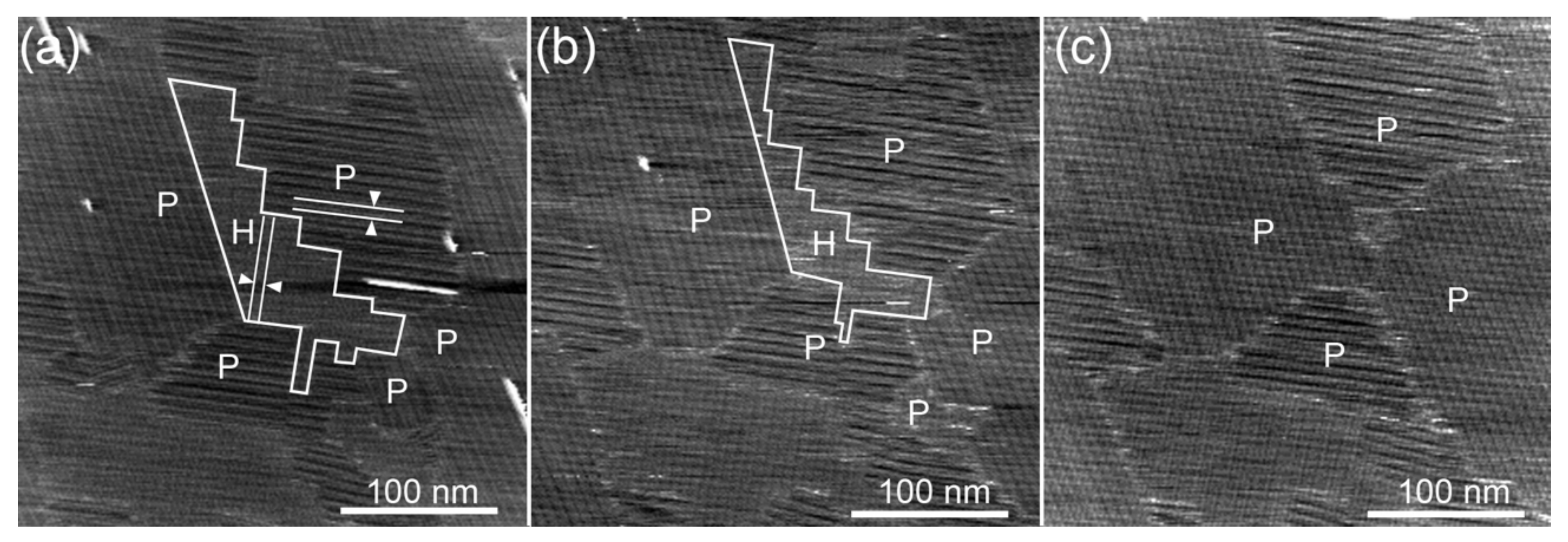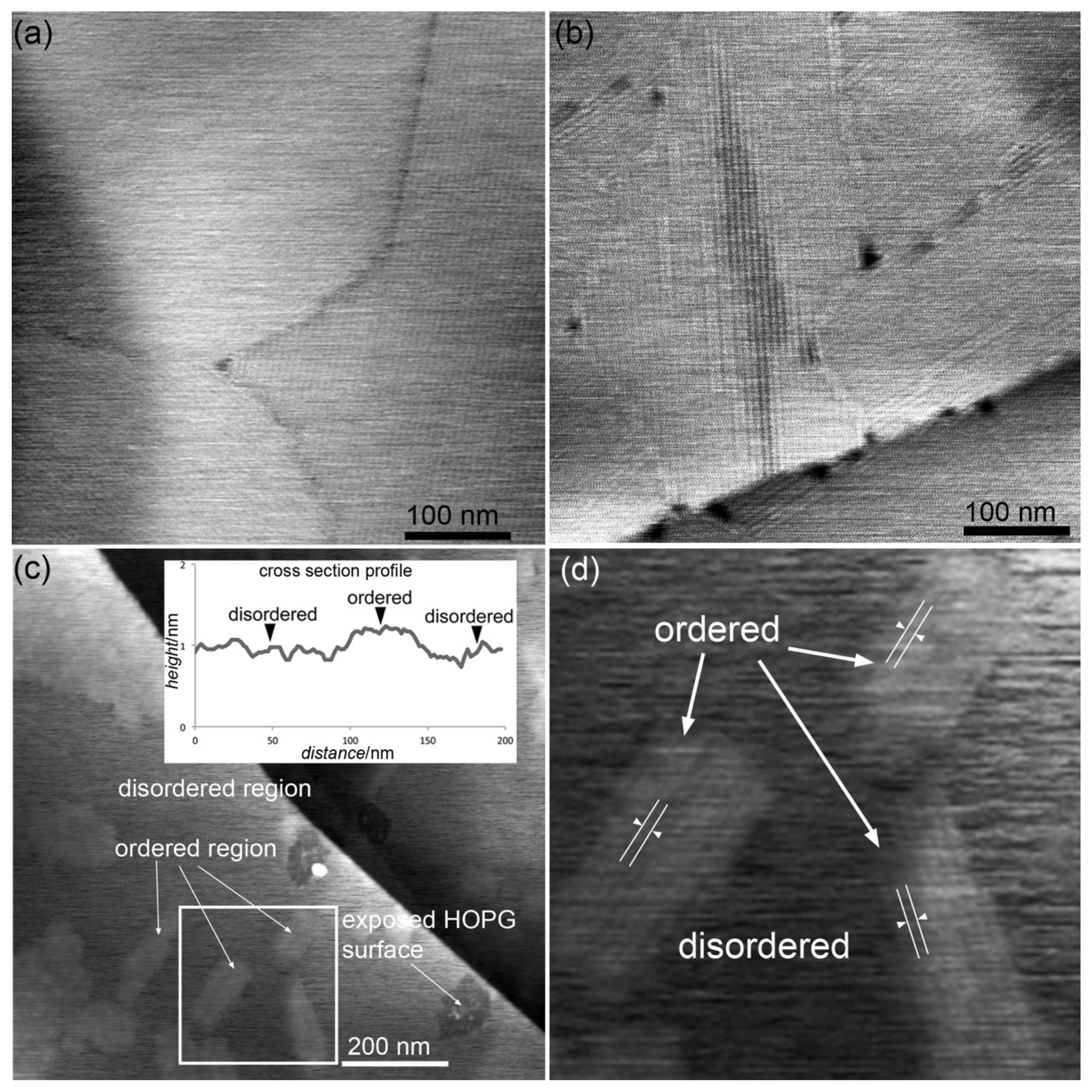Stability of Two-Dimensional Polymorphs for 10,12-Pentacosadyn-1-ol on Graphite Investigated by SPM
Abstract
:1. Introduction
2. Materials and Methods
2.1. Sample Preparations
2.2. Scanning Probe Microscopy
3. Results and Discussion
4. Conclusions
Acknowledgments
Author Contributions
Conflicts of Interest
References
- Lafferentz, L.; Eberhardt, V.; Dri, C.; Africh, C.; Comelli, G.; Esch, F.; Hecht, S.; Grill, L. Controlling On-Surface Polymerization by Hierarchical and Substrate-Directed Growth. Nat. Chem. 2012, 4, 215–220. [Google Scholar] [CrossRef] [PubMed]
- Cai, J.; Ruffieux, P.; Jaafar, R.; Bieri, M.; Braun, T.; Blankenburg, S.; Muoth, M.; Seitsonen, A.P.; Saleh, M.; Feng, X.; et al. Atomically Precise Bottom-up Fabrication of Graphene Nanoribbons. Nature 2010, 466, 470–473. [Google Scholar] [CrossRef] [PubMed]
- Liu, X.; Guan, C.; Ding, S.; Wang, W.; Yan, H.; Wang, D.; Wan, L. On-Surface Synthesis of Single-Layered Two-Dimensional Covalent Organic Frameworks via Solid–Vapor Interface Reactions. J. Am. Chem. Soc. 2013, 135, 10470–10474. [Google Scholar] [CrossRef] [PubMed]
- Han, P.; Akagi, K.; Canova, F.F.; Mutoh, H.; Shiraki, S.; Iwaya, K.; Weiss, P.S.; Asao, N.; Hitosugi, T. Bottom-Up Graphene-Nanoribbon Fabrication Reveals Chiral Edges and Enantioselectivity. ACS Nano 2014, 8, 9181–9187. [Google Scholar] [CrossRef] [PubMed]
- Zhang, H.; Gong, Z.; Sun, K.; Duan, R.; Ji, P.; Li, L.; Li, C.; Müllen, K.; Chi, L. Two-Dimensional Chirality Transfer via On-Surface Reaction. J. Am. Chem. Soc. 2016, 138, 11743–11748. [Google Scholar] [CrossRef] [PubMed]
- Okawa, Y.; Aono, M. Nanoscale control of chain polymerization. Nature 2001, 409, 683–684. [Google Scholar] [CrossRef] [PubMed]
- Okawa, Y.; Mandal, S.K.; Hu, C.; Tateyama, Y.; Goedecker, S.; Tsukamoto, S.; Hasegawa, T.; Gimzewski, J.K.; Aono, M. Chemical Wiring and Soldering toward All-Molecule Electronic Circuitry. J. Am. Chem. Soc. 2011, 133, 8227–8233. [Google Scholar] [CrossRef] [PubMed]
- Nakaya, M.; Okawa, Y.; Joachim, C.; Aono, M.; Nakayama, T. Nanojunction between Fullerene and One-Dimensional Conductive Polymer on Solid Surfaces. ACS Nano 2014, 8, 12259–12264. [Google Scholar] [CrossRef] [PubMed]
- Takajo, D.; Inaba, A.; Sudoh, K. Two Polymorphic Forms of 10,12-Pentacosadiyn-1-ol Molecular Layers on Graphite Transferred from an Aqueous Surface. Surf. Sci. 2014, 620, 38–44. [Google Scholar] [CrossRef]
- Takajo, D.; Inaba, A.; Sudoh, K. Two-Dimensional Solid-State Topochemical Reactions of 10,12-Pentacosadiyn-1-ol Adsorbed on Graphite. Langmuir 2014, 30, 2738–2744. [Google Scholar] [CrossRef] [PubMed]
- Giridharagopal, R.; Kelly, K.F. STM-Induced Desorption of Polydiacetylene Nanowires and Reordering via Molecular Cascades. J. Phys. Chem. C 2007, 111, 6161–6166. [Google Scholar] [CrossRef]
- Feenstra, R.M.; Slavin, A.J.; Held, G.A.; Lutz, M.A. Edge Melting of the Ge(111) Surface Studied by Scanning Tunneling Microscopy. Ultramicroscopy 1992, 42, 33–40. [Google Scholar] [CrossRef]
- Poirier, G.E.; Tarlov, M.J.; Rushmeier, H.E. Two-Dimensional Liquid Phase and the p×√3 Phase of Alkanethiol Self-Assembled Monolayers on Au(111). Langmuir 1994, 10, 3383–3386. [Google Scholar] [CrossRef]
- Kondoh, H.; Kodama, C.; Sumida, H.; Nozoye, H. Molecular Processes of Adsorption and Desorption of Alkanethiol Monolayers on Au(111). J. Chem. Phys. 1999, 111, 1175–1184. [Google Scholar] [CrossRef]
- Bucher, J.; Roeder, H.; Kern, K. Thermally Induced Disorder and Conformational Defects of Alkane Monolayers on Graphite. Surf. Sci. 1993, 289, 370–380. [Google Scholar] [CrossRef]
- Morishige, K.; Kato, T. Chain-Length Dependence of Melting of n-Alcohol Monolayers Adsorbed on Graphite: n-Hexanol, n-Heptanol, n-Octanol, and n-Nonanol. J. Chem. Phys. 1999, 111, 7095–7102. [Google Scholar] [CrossRef]
- Morishige, K. Structure and Melting of a Monolayer Ethanol Film on Graphite. J. Chem. Phys. 1992, 97, 2084–2089. [Google Scholar] [CrossRef]






© 2018 by the authors. Licensee MDPI, Basel, Switzerland. This article is an open access article distributed under the terms and conditions of the Creative Commons Attribution (CC BY) license (http://creativecommons.org/licenses/by/4.0/).
Share and Cite
Takajo, D.; Sudoh, K. Stability of Two-Dimensional Polymorphs for 10,12-Pentacosadyn-1-ol on Graphite Investigated by SPM. Appl. Sci. 2018, 8, 503. https://doi.org/10.3390/app8040503
Takajo D, Sudoh K. Stability of Two-Dimensional Polymorphs for 10,12-Pentacosadyn-1-ol on Graphite Investigated by SPM. Applied Sciences. 2018; 8(4):503. https://doi.org/10.3390/app8040503
Chicago/Turabian StyleTakajo, Daisuke, and Koichi Sudoh. 2018. "Stability of Two-Dimensional Polymorphs for 10,12-Pentacosadyn-1-ol on Graphite Investigated by SPM" Applied Sciences 8, no. 4: 503. https://doi.org/10.3390/app8040503




